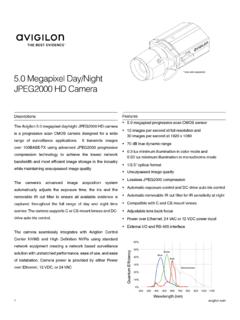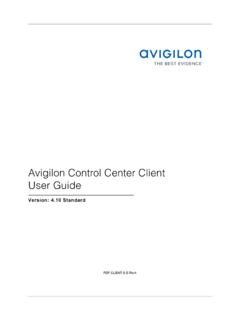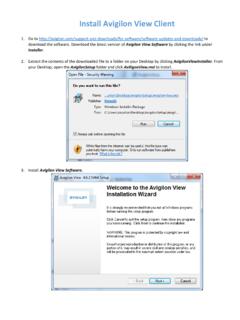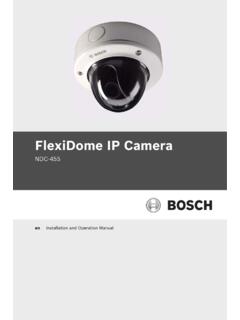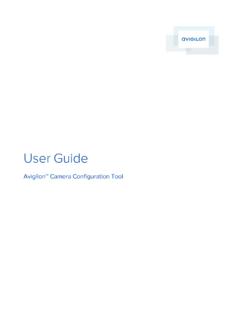Transcription of Avigilon Camera Installation Tool User Guide
1 Avigilon Camera Installation tool user Guide Version PDF-CIT-D-Rev1 Copyright 2011 Avigilon . All rights reserved. The information presented is subject to change without notice. No copying, distribution, publication, modification, or incorporation of this document, in whole or part, is permitted without the express written permission of Avigilon . In the event of any permitted copying, distribution, publication, modification, or incorporation of this document, no changes in or deletion of author attribution, trademark legend, or copyright notice shall be made. No part of this document may be reproduced, stored in a retrieval system, published, used for commercial exploitation, or transmitted, in any form by any means, electronic, mechanical, photocopying, recording, or otherwise, without the express written permission of Avigilon . Avigilon Tel + Fax + Revised 2011-10-18 iii Table of Contents What is the Avigilon Camera Installation tool ?
2 1 Using the Installation tool .. 2 Zooming and Panning a Video .. 3 Using the Zoom Tools .. 3 Using the Pan Tools .. 3 Making a View Full Screen .. 3 Ending Full Screen .. 4 Network .. 4 Changing Camera Network Settings .. 4 Image and Display .. 5 Compression and Image Rate .. 8 Changing Compression and Image Rate Settings .. 8 Upgrading Camera Firmware ..10 For More Information ..11 Avigilon University .. 11 Support .. 11 Upgrades .. 11 Feedback .. 11 1 What is the Avigilon Camera Installation tool ? The Avigilon Camera Installation tool allows you to connect and configure Avigilon cameras for your surveillance system. The Installation tool allows you to preview the Camera video, adjust the video image, and define how the Camera connects to the network. A copy of the Installation tool is available online from the Avigilon website. You do not need a license to use the Installation tool .
3 For a video overview of the Installation tool , see Module 4 - Avigilon Camera Installation tool in the Avigilon University - Field Technician Stream. 2 Using the Installation tool Once a Camera has been connected to the local network or directly to the computer running the Installation , you can use the Avigilon Camera Installation tool to configure the cameras for use in your surveillance system. 1. Open the Installation tool . o Double-click the Avigilon Camera Installation tool shortcut on your desktop. o From the Windows Start menu, select Programs > Avigilon > Avigilon Camera Installation tool . When the Installation tool opens, the application automatically discovers all the cameras that are connected to the local network. 2. In the Connect Camera dialog box, select the Camera you want to configure and click Connect. The Camera 's video is displayed in the View pane. 3.
4 Adjust the video display in the Installation tool . o Use the Zoom and Pan tools to help you see the Camera video from different angles and depths of view. See Zooming and Panning for more information. o Click Full Screen to maximize the View pane to use the entire monitor. See Making a View Full Screen for more information. 4. Click Network to set the Camera 's IP address or configure the Camera to be part of an IP multicast. See Network for more information. 5. Click Image and Display to adjust the Camera 's display settings for watching live and recorded video. This is where the Camera 's zoom and focus settings can be defined. See Image and Display for more information. Using the Installation tool 3 6. Click Compression and Image Rate to configure the Camera 's video compression level and image rate for transmitting video through the network. See Compression and Image Rate for more information.
5 7. Click Connect Camera to configure another Camera . In the Camera Connection dialog box, select a Camera from the left pane and click Connect. Zooming and Panning a Video The zoom and pan tools allow you to focus on specific regions in a Camera video. Using the Zoom Tools The most common way to zoom in and out of the video image is to rotate the scroll wheel on your mouse. You can also press the Up and Down arrows on your keyboard to perform the same action. The software also includes a set of Zoom tools that can be used with your mouse: 1. Select a Zoom tool : o On the toolbar, click Zoom In tool or Zoom Out tool . 2. Click the image panel until you reach the desired zoom depth. Using the Pan Tools You can right-click and drag inside an image panel to pan the video image. Or, you can use the Pan tool : 1. Select the Pan tool : o On the toolbar, click Pan tool . 2. Drag the video image in any direction inside the image panel.
6 Making a View Full Screen You can maximize a View to make full use of a monitor. On the toolbar, click Full Screen. Avigilon Camera Installation tool user Guide 4 Ending Full Screen On the toolbar at the top left of the screen, click End Full Screen. Tip: The toolbar is hidden when the application is idle. Move your mouse to display the toolbar. Network Use the Camera Network dialog box to change how the Camera connects to the server network. Changing Camera Network Settings 1. Click Network. 2. In the Network dialog box, select how the Camera obtains an IP address: Figure Obtain an IP address automatically: select this option for the Camera to connect to the network through an automatically assigned IP address. Network dialog box Using the Installation tool 5 The Camera will attempt to obtain an address from a DHCP server. If it cannot, the Camera will default to addresses in the range.
7 O Use the following IP address: select this option to manually assign a static IP address for the Camera . Enter the IP Address, Subnet Mask and Gateway you want the Camera to use. 3. Select the Control Port for connecting to the Camera . This port is also used for manually discovering the Camera on the network. 4. Select the Enable Multicast check box to enable multicast streaming from the Camera . You must enable multicast to set up redundant connections to multiple servers. Use the default generated IP Address, TTL and Base Port, or enter your own values. 5. Click OK. Image and Display Use the Image and Display dialog box to adjust the Camera s display settings for live and recorded video. Note: Some of the following options may not appear if the Camera feature cannot be adjusted through the application. 1. Click Image and Display. The Image and Display dialog box is displayed.
8 Avigilon Camera Installation tool user Guide 6 Figure In the Image and Display dialog box, use the Zoom controls to adjust the Camera 's zoom position. Image and Display dialog box 3. If the Camera has a built-in auto focus feature, you can select the Continuous Focus option to enable the Camera to focus itself whenever the scene changes. 4. To manually focus the Camera , select Open in the Iris drop down list then use the Focus buttons to focus the Camera . The left arrow buttons focus the Camera towards Zero, and the right arrow buttons focus the Camera towards Infinity. Click the Auto Focus button to enable the Camera to automatically focus once. Note:5. Make the required changes to adjust the Camera 's image settings. Once the focus is manually set, it will not change. Tip: Use the Maximum Exposure, Maximum Gain and PriorityOption options to control low light behavior.
9 Description You can allow the Camera to control the exposure by selecting Exposure Automatic, or you can set a specific exposure rate. Note: Increasing the manual exposure time may affect the image rate. Using the Installation tool 7 You can allow the Camera to control the iris by selecting Iris Automatic, or you can manually set it to Open or Closed. You can allow the Camera to control the infrared cut filter by select IR Cut Filter Automatic, or set the Camera to Color or Monochrome mode. If your video image flickers because of the fluorescent lights around the Camera , you can reduce the effects of the flicker by setting the Flicker Control to the same frequency as your lights. Generally, Europe is Flicker Control 50Hz and North America is 60Hz. If your scene has areas of intense light that cause the overall image to be too dark, move the Backlight Compensation Backlight Compensation slider until you achieve a well exposed image.
10 You can limit the automatic exposure setting by selecting a maximum exposure level. Maximum Exposure By setting a maximum exposure level for low light situations, you can control the Camera 's exposure time to let in the maximum amount of light without creating blurry images. You can limit the automatic gain setting by selecting a maximum gain level. Maximum Gain By setting a maximum gain level for low light situations, you can maximize the detail of an image without creating excessive noise in the images. You can set Priority Image Rate or ExposureWhen set to as the priority. Image RateWhen set to , the Camera will maintain the set image rate as the priority, and will not adjust the exposure beyond what can be recorded for the set image rate. Exposure, the Camera will maintain the exposure setting as the priority, and will override the set image rate to achieve the best image possible.



